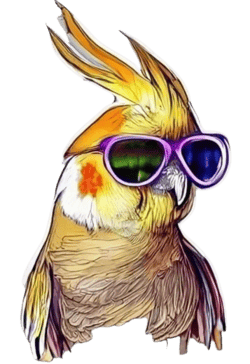How do Cockatiels See: Unique Avian Vision Explained!
Doesn’t it fill you with wonder when you think about how other creatures, especially our feathery friends, perceive the world around us? Today, let’s unravel the mystery of the peculiar vision of a beloved pet bird – the cockatiel.
Introduction: The Fascinating World of Cockatiel’s Vision
Relatives to the cockatoo, cockatiels are one of the most popular pet birds around the world. They’re loved for their playful personalities, melodious chirping, and of course, their crest feathers that are as expressive as eyebrows! But there’s an aspect about cockatiels that’s incredibly intriguing – their extraordinary vision.
As bird owners and bird-lovers, enhancing our understanding of cockatiel vision can provide us with a richer and more respectful connection with these beautiful creatures. Plus, it can also help us meet their needs better and provide them with a joyful and stimulating environment. So, shall we dive in?
Biological Attributes: What Makes Cockatiel Eyes Exceptional
A cockatiel’s eye is a miraculous organ. Their eyes are larger in comparison to the size of their heads, giving them a wide field of view. What’s fascinating is that they possess a third eyelid – the nictitating membrane, essentially acting as a built-in pair of goggles, saving their eyes from dust and injury!
But what might defy common knowledge is the presence of cone cells. Much like humans, cockatiels have cone cells in their retina that allow them to perceive colors. However, while humans have only three types of cone cells, cockatiels, like many birds, have a fourth type that enables them to see a wider spectrum of colors – even ultraviolet light!
Color Perception: The Vibrant World Through a Cockatiel’s Eyes
Can you imagine seeing more colors than a rainbow has? That’s what it’s like for a cockatiel! While we can see colors derived from red, green, and blue wavelengths, their vision extends to ultraviolet wavelengths. Simply put, we’re not just talking about a bigger color palette, but more nuanced shades and tints that are imperceptible to human eyes.
Evidence of this exceptional color sensitivity comes from several studies, like how cockatiels can discriminate between hundreds of shades of grey – making our ‘50 shades’ seem rather dull in contrast!
Vision Adaptation: The Dynamic changes in Cockatiel’s Sight
Now, having the ability to see the world with such vibrant detail also comes with certain requirements. Cockatiels are champions at adjusting their vision in different light conditions while maintaining their ability to see a panorama of colors. This is why they sometimes nap with one eye open – it’s their way of adjusting the light input to each eye!
With a large portion of their vision offering peripheral sight, cockatiels also have a small overlap in front that allows binocular vision – hence their side-eyed stare that we all adore!
Cockatiels Behaviour: Influence of Vision on Cockatiel Lifestyle
Vision affects several areas of their behavior. Take feeding habits, for instance. In the wild, this expanded color vision could help them pick out ripe fruits or find diverse types of plants to nibble on.
Color perception also has great significance in mate selection. Cockatiels are more likely to choose mates with brighter and UV-reflecting plumage – a sign of good health and superior genetics.
And let’s not forget flight! Their dynamic vision allows them better judgement of distance and depth, ensuring safe and accurate flights.
If you’re curious about why your cockatiel hisses, check out our guide on “Why Does My Cockatiel Hiss.“
Practical Guide: Catering to Your Cockatiel’s Vision Needs
While we can’t recreate a cockatiel’s natural habitat, understanding their vision needs can help us enhance their living conditions. Ensuring plenty of natural light can stimulate their color-perception abilities.
Including a variety of colored toys and enrichments can provide stimulation and allow them to exercise their color recognition skills.
Regular vet check-ups are crucial to monitor the health of their eyes and ensure they’re not developing any diseases.
Conclusion: Appreciating the Majestic View from a Cockatiel’s Perch
So there we have it – an insight into the vivid, sophisticated world of cockatiels’ vision. With an understanding of their unique vision, we can connect more deeply with our Cockatiel friends, take better care of them, and appreciate the colorful world they perceive.
FAQs: Resolving Your Doubts about Cockatiel Vision
- Does my cockatiel see the same colors as I do?
No, cockatiels can see a wider spectrum of colors including ultraviolet light, which humans can’t perceive. - Why does my cockatiel seem to react to certain colors?
Cockatiels have a high color sensitivity. Their reactions to certain colors could be attributed to their individual preferences or instincts. - How can I tell if my cockatiel’s vision is healthy?
Regular visits to the vet are the best way to ensure your cockatiel’s vision is healthy. There might be subtle signs like disorientation, difficulty in flying or lack of interest in colorful toys which might indicate vision problems. - What can I do to enhance my pet cockatiel’s vision?
Provide an environment with good light exposure, offer a range of colorful toys for stimulation, and ensure regular vet check-ups for your feathered friend.
Remember, their sight is not only a vital sense but a window into a world more colorful than we can perceive. So, let’s appreciate, understand and care for it!

About Me
I’m Kamran, a co-founder and content creator at cockatielhq.com. With 8+ years in the world of avian enthusiasts, I’ve gained extensive knowledge in caring for birds. From egg-laying and mating to cohabitation with other birds, dietary needs, nurturing, and breeding, I’m here at cockatielhq.com to share valuable insights for your avian companions.








2 Comments